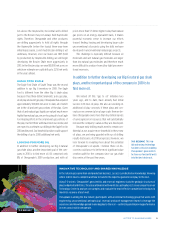Chesapeake Energy 2009 Annual Report Download - page 21
Download and view the complete annual report
Please find page 21 of the 2009 Chesapeake Energy annual report below. You can navigate through the pages in the report by either clicking on the pages listed below, or by using the keyword search tool below to find specific information within the annual report.
OPERATING AREAS 18
6
8
9
7
10
East Texas, Gulf Coast, South Texas and Louisiana In East
Texas, Chesapeake owns significant vertical natural gas production from wells that
produce from various tight natural gas sand formations in medium to deep horizons, in-
cluding the Pettet, Travis Peak and Cotton Valley formations. In addition, we are a
major leasehold owner in the Deep Bossier Sand play. We have established a signif-
icant presence in a number of counties along the prolific Texas Gulf Coast, where we
utilize 3-D seismic data to delineate structural and stratigraphic traps, primarily in the Frio,
Yegua and Wilcox formations. This area has been de-emphasized as we move our drilling
away from legacy vertical natural gas drilling to horizontal natural gas and oil drilling in
unconventional plays.
Haynesville/Bossier Shales In early 2008, Chesapeake announced its
discovery of the Haynesville Shale, a reservoir that likely will become one of the two
largest natural gas fields in the U.S. (along with the Marcellus) and one of the five largest in the
world. The Haynesville Shale is now the nation’s second-largest producing shale play. The
Bossier Shale lies above and overlaps much of our Hayneville prospective leasehold. We
are the largest leasehold owner and most active driller of new wells in the Haynesville/Bossier
shale play, which is located in northwestern Louisiana and East Texas. We estimate we could
drill up to 8,750 net wells on our Haynesville/Bossier Shale acreage in the future and plan to utilize
an average of 35 operated rigs in 2010 to further develop our 520,000 net leasehold acres of Haynesville/Boss-
ier Shale. Chesapeake and its 20% joint venture partner, Plains Exploration & Production Company (NYSE:PXP),
are producing from more than 200 net wells in the Haynesville play and continue to experience outstanding drill-
ing results. PXP paid us approximately $400 million in drilling carries in 2009 and paid $1.1 billion in September 2009
as a result of an amendment to our joint venture agreement that eliminated PXP’s future carry obligations.
Marcellus Shale Chesapeake is the largest leasehold owner and most active driller in the
Marcellus Shale play that spans from northern West Virginia across much of Pennsylvania into
southern New York. The Marcellus is located near the highest gas-consuming region of the U.S. and
therefore receives the best natural gas prices in the U.S. We estimate we could drill up to 20,000
net wells on our Marcellus acreage in the future and plan to utilize an average of 31 operated rigs in
2010 to further develop our 1.6 million net acres of Marcellus leasehold. During 2009, approxi-
mately $160 million of Chesapeake’s drilling costs in the Marcellus were paid for by its joint
venture partner, Statoil (NYSE:STO, OSE:STL). During 2010 through 2012, 75% of Chesa-
peake’s drilling costs (approximately $2.0 billion) in the Marcellus will be paid for by STO.
We remain very active in acquiring additional leasehold in the Marcellus and expect that over
time, it will become the largest natural gas field in the U.S. and the second largest in the world.
Eagle Ford Shale As part of a growing emphasis on increasing its oil and natural
gas liquids production, Chesapeake has recently built one of the top five industry leasehold
positions in the Eagle Ford Shale play in South Texas. At year-end 2009, the company owned approxi-
mately 80,000 net acres of Eagle Ford leasehold and now has 300,000 net acres. Our focus has
been on the oil and wet gas prone portions of the play and we plan to utilize an average of
four operated rigs in 2010 to further develop our growing Eagle Ford leasehold position.
Permian and Delaware Basins In the northern portion of the
Permian Basin, Chesapeake has focused on discovering and developing various
shallow- to medium-depth horizontal oil plays and also operates a number of secondary
recovery oil projects. We plan to utilize an average of six operated rigs in 2010 to further
develop our 2.15 million net acres of leasehold in the Permian and Delaware Basins. Our
new horizontal oil projects in this area, including the Avalon Shale and the Bone Spring
Sand, have the potential to deliver significant upside as we move towards substantially
increasing our oil production in the years ahead.
2009 Total Production:
0 bcfe, NM, NM
12/31/09 Proved Reserves:
0 bcfe, NM, NM
12/31/09 Net Leasehold Acres:
80,000, NM, 1%
(300,000 as of 3/31/10)
2009 Total Production:
75 bcfe, -6%, 8%
12/31/09 Proved Reserves:
740 bcfe, -20%, 5%
12/31/09 Net Leasehold Acres:
2,150,000, -23%, 16%
2009 Total Production:
85 bcfe, +183%, 10%
12/31/09 Proved Reserves:
1,830 bcfe, +408%, 13%
12/31/09 Net Leasehold Acres:
520,000, +13%, 4%
2009 Total Production:
15 bcfe, +200%, 2%
12/31/09 Proved Reserves:
260 bcfe, +550%, 2%
12/31/09 Net Leasehold Acres:
1,620,000, +30%, 12%
2009 Total Production:
65 bcfe, -38%, 7%
12/31/09 Proved Reserves:
560 bcfe, -51%, 4%
12/31/09 Net Leasehold Acres:
610,000, -48%, 5%
























